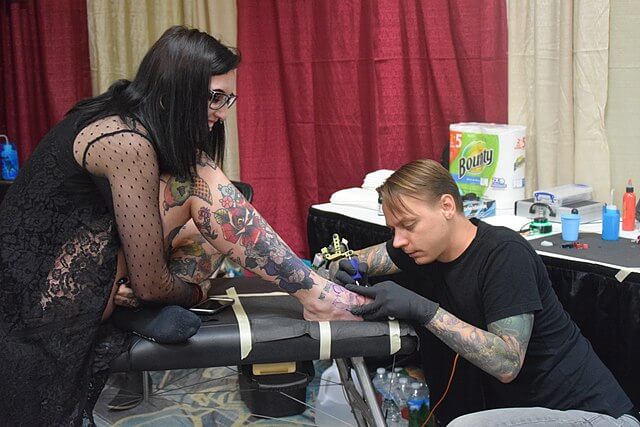Few subjects have their relationships portrayed as wrongly as science and art. Popular culture presents art and science as natural opposites, one the domain of emotion and the other of hard math, with nothing to say to each other.
We here at Talk Science to Me disagree completely. Art and science are the most natural partners since gravy and cheese curds. (Ask your favourite Canadian if you don’t get it.) Getting people to understand difficult topics requires more than mathematical formulas and dense, precise prose. Art brings to science an understanding of what affects people, what connects ideas in a helpful way, and how to arrange the pieces of a story to make sure that the person receiving it comes away with the desired message. Conversely, science is also necessary for creating art. Science has studied how narrative structures create effective or ineffective stories, how visual composition affects the impression made by photos and paintings, and numerous other details about how art works. More than that, art depends critically on science to understand the materials of which it is made. Materials science explains how textiles interact when bonded together, which inks mix with or overlay which other inks in an artwork, and how to safely store and handle old books to keep them from disintegrating. Far from being opposites, art and science are in endless conversation, and nowhere is this more evident than in the art of tattooing.
Tattooing, the practice of placing ink permanently inside living skin to create visible designs, is something humans have done since the earliest days of our species. Ancient human remains, such as Ötzi the iceman and various ancient Scythians, still show their tattoos, confirming that the practice of inking one’s skin goes back over 5,000 years and spans the world. Body ink with ritual significance is found across the Americas in particular, and numerous First Nations, Inuit and other Indigenous peoples are revitalizing their tattoo traditions after colonial suppression. Indeed, the word “tattoo” itself descends from the Polynesian word rendered as tatu or tatau in various languages from that wide-spanning Pacific family. Whether richly colored Yakuza symbology from Japan, the characteristic style of maritime tattoos collected by sailors, or the markings inflicted on prisoners during especially dark chapters of world history, tattoos are everywhere in the human story. Where they haven’t been very much, oddly, is in science; few studies have examined how they work. But that is changing.

Tattoos, regardless of tradition or culture, operate in roughly the same way: pigment is driven into the gap between the epidermis and the dermis using a slim, sharp implement. This is important to understand: the skin itself has not been dyed. Tattoo ink does not chemically bond to its medium the way textile dye makes colourful fabric or printing marks paper. The ink is still in its original, chemically unaltered form and shows because skin, including very dark skin, is far more transparent than most people realize. (This same reality is why making realistic-looking computer-animated people for use in film is so difficult.) Since the ink is below the epidermis, it does not shed with the epidermis’s natural renewal cycle and can last a lifetime, and it also looks different than it did on the tattooist’s needle. Being inside the skin has one more important consequence: tattoo ink is exposed to the natural circulating fluids of the body, in particular the lymphatic system. This is where things get interesting.
Veterans of the tattoo scene have likely noticed that the site of a fresh or in-progress tattoo tends to swell and might bleed or otherwise leak fluid, which the artist must wipe away to see what they are doing. Tattooing involves needles, after all, and as with any other injury, a tattoo induces an inflammatory response, in which the body directs fluid and immune cells to the injured site. Immune cells converging on ink inside the skin sounds like a problem, as does the reality that the macrophages the body sends to the tattoo site immediately busy themselves with gorging on that tattoo ink, but surprisingly, the opposite is true. The ink inside a macrophage is just as visible as it was before, and macrophages cannot degrade any but the most bio-compatible inks. What’s more, even when those macrophages themselves die, others arrive to take the ink into themselves. As a result, only a small amount of the tattoo’s ink escapes its placement over time, arriving in the lymph fluid and eventually being purged in the urine, and the overall design is effectively permanent.
Tattoos are already a striking example of “living art,” the result of people altering their own bodies with colour and linework to create intentional markings. This understanding of their immunology adds another layer to this ancient tradition: tattoos, in effect, are themselves alive. A key part of the reality of tattoos is that they are biologically, immunologically active, and that without this immunological component, tattoos likely would not work as well or last as long as they do. What’s more, this characteristic perhaps helps explain the other strange reality of tattooing: that some inks degrade over time in response to specific nutrient deficiencies. This knowledge that tattoos are not static may yet provide better, less painful alternatives to current laser-based methods of tattoo removal or otherwise inform the complex science of immunology in new and surprising ways.
Art and science will ever be in exciting, fascinating conversation with one another, and we here at Talk Science to Me have the writing, editing and graphic design expertise to make sure we are at the centre of that conversation. Have a look at our portfolio to see what we can do for you.